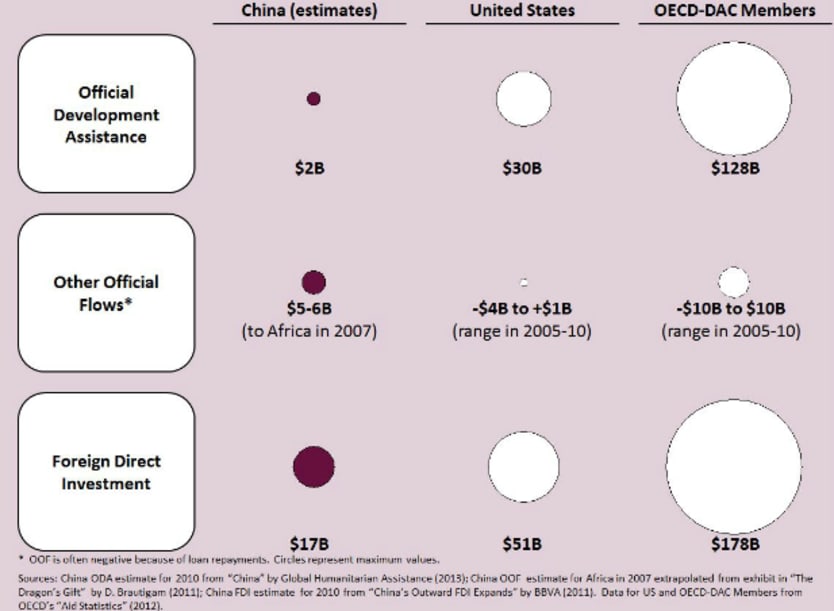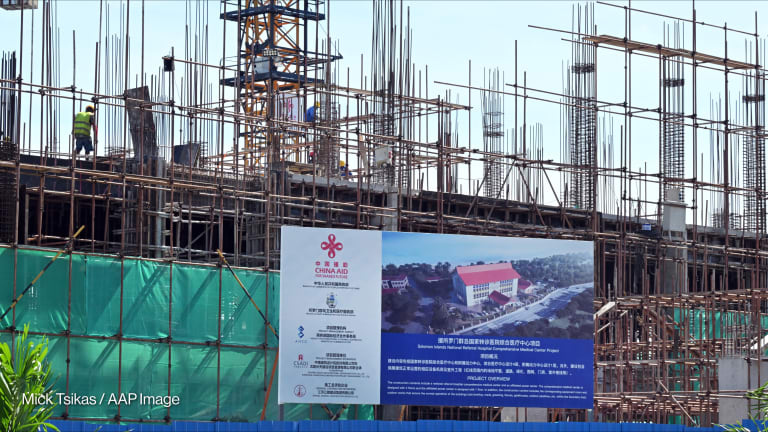
EDITOR’S NOTE: Analyzing Chinese foreign aid against the traditional concept of official development assistance is like comparing apples and oranges, thus giving “an inaccurate picture of the global aid and investment landscape,” argue Paul Callan, Jasmin Blak, and Andria Thomas of Dalberg Global Development Advisors in a blog for the Council on Foreign Relations. China’s broader foreign assistance flows, they say, match or surpass those from the United States and other traditional donors.
China has significantly expanded aid to and investment in developing countries in recent years. This expansion has been the subject of much debate, with many development scholars and policymakers seeking to understand how Chinese foreign assistance compares with that of “traditional” OECD [Organization for Economic Cooperation and Development] donors. However, many analyses compare official development assistance from traditional donors to a more varied collection of financial tools employed by China. These apples-to-oranges comparisons sometimes give an inaccurate picture of the global aid and investment landscape. A more careful analysis shows that while China gives relatively little ODA [official development assistance], its broader foreign assistance flows already match or exceed those from the United States and other OECD countries.
ODA — defined by the OECD to include grants, interest-free loans, and concessional loans — is the most frequently cited metric for foreign aid. China does not give much aid by this measure: Its ODA was estimated to be $2 billion in 2010, which equates to 0.04 percent of its gross national income. By comparison, U.S. ODA was $30 billion in 2010, equivalent to 0.21 percent of GNI, and all members of the OECD’s Development Assistance Committee — the main group of traditional donors — gave $128 billion in ODA in 2010.
Why, then, is China viewed as a significant donor? To understand, we need to look at other types of government assistance and at private sector funding flows.
Official assistance can be defined more broadly by adding to ODA a range of funds outside the OECD’s definition, such as export credits, natural-resource-backed lines of credit, subsidies for private investment, and mixed credits (combined concessional and market-rate loans). These are called “other official flows” by the OECD-DAC. OOF are usually distinguished from ODA by traditional donors because of concerns about the development implications of strings frequently attached to OOF arrangements, such as tying the funds to the use of products and services from the donor country.
China’s export credits and other types of OOF are larger than its ODA. Chinese OOF to Africa alone are estimated to have been about $5-6 billion in 2007. The U.S. and other OECD-DAC countries also provide various forms of OOF, but at a scale far below that of China. Annual U.S. OOF to all developing countries, net of repayments, never exceeded $1 billion during the period 2005 to 2010. To take one example, the Export-Import Bank of the United States authorized just under $10 billion in loans and other financing to Africa during the last eight years, during which time its Chinese counterpart is reported to have authorized $38 billion for the continent.
Foreign direct investments are private financial flows that count as neither ODA nor OOF. In China’s case, however, FDI is relevant to the discussion of foreign aid because state-owned companies likely account for a substantial proportion of FDI, making it harder to distinguish between public and private flows. For example, the single largest direct Chinese investment in Africa to date is the $5 billion purchase by the state-owned Industrial and Commercial Bank of China Ltd. of a 20 percent stake in South Africa’s Standard Bank in 2008. In all, China’s FDI to developing countries was estimated to be approximately $17 billion in 2010, representing an FDI to GNI ratio of 0.3 percent, roughly equal to that of the United States. Looking at sub-Saharan Africa specifically, China’s FDI to GNI ratio is greater than that of the U.S., though its absolute number is slightly less ($12.7 billion in 2007 to 2011 versus $16.6 billion).
Some of the confusion in the conversation about aid and investment stems from differences in philosophy. The Chinese government explicitly considers other developing countries to be business partners more than aid recipients in its economic diplomacy strategy. Consequently, the foreign assistance described in the government’s 2011 “China’s Foreign Aid” white paper and 2006 “African Policy” paper outlines many forms of non-ODA finance that China considers cooperative, including export buyer’s credits, preferential trade relationships and support for Chinese firms investing in developing countries. OECD-DAC members, by contrast, distinguish clearly between monies that they consider aid to developing countries (and the poor within them) and other flows related to commerce.
As China and other emerging donors come to contribute more to developing countries, it would be beneficial to have more accurate and consistent reporting across all donors. Comparable reporting standards could draw from both OECD definitions and emerging donor conventions, such as the Chinese practice of treating only the reduction in interest on concessional loans (rather than the whole loan) as ODA. More consistent data would enable developing countries and international development actors to better understand the nature of financial flows to their economies, and consequently to design better policies to harness these flows.
Edited for style and republished with permission from the Council on Foreign Relations. Read the original article.








